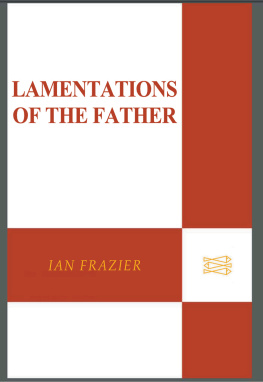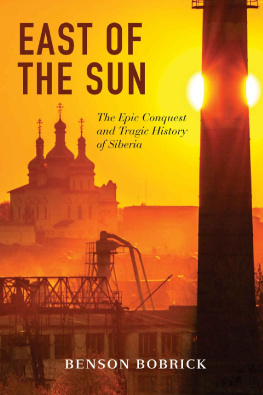ALSO BY IAN FRAZIER
DATING YOUR MOM
NOBODY BETTER, BETTER THAN NOBODY
GREAT PLAINS
FAMILY
COYOTE V. ACME
IT HAPPENED LIKE THIS (TRANSLATOR)
ON THE REZ
THE FISHS EYE
GONE TO NEW YORK
LAMENTATIONS OF THE FATHER
TRAVELS IN SIBERIA
TRAVELS IN SIBERIA
Ian Frazier

Farrar, Straus and Giroux New York
Farrar, Straus and Giroux
18 West 18th Street, New York 10011
Copyright 2010 by Ian Frazier
Map copyright 2010 by Jeffrey L. Ward
All rights reserved
Distributed in Canada by D&M Publishers, Inc.
Printed in the United States of America
First edition, 2010
Portions of this book originally appeared, in somewhat different form, in The New Yorker.
Grateful acknowledgment is made to Katya Arnold for permission to print the sketch on Chapter 3. All other illustrations are by the author.
Library of Congress Cataloging-in-Publication Data
Frazier, Ian.
Travels in Siberia / Ian Frazier.1st ed.
p. cm.
Includes bibliographical references and index.
ISBN 978-0-374-27872-4 (hardcover : alk. paper)
1. Frazier, IanTravelRussia (Federation)Siberia. 2. Siberia (Russia)Description and travel. 3. Siberia (Russia)History. 4. Siberia (Russia)Social life and customs. 5. Siberia (Russia)History, Local. I. Title.
DK756.2 .F73 2010
957dc22
2010005784
Designed by Jonathan D. Lippincott
www.fsgbooks.com
10 9 8 7 6 5 4 3 2 1
The author has omitted some names and identifying characteristics.
To Jay, again, with love
Contents

PART I

Chapter 1
Officially, there is no such place as Siberia. No political or territorial entity has Siberia as its name. In atlases, the word Siberia hovers across the northern third of Asia unconnected to any place in particular, as if designating a zone or a condition; it seems to show through like a watermark on the page. During Soviet times, revised maps erased the name entirely, in order to discourage Siberian regionalism. Despite this invisibility, one can assume that Siberias traditional status as a threat did not improve.
A tiny fraction of the worlds population lives in Siberia. About thirty-nine million Russians and native peoples inhabit that northern third of Asia. By contrast, the state of New Jersey, where I live, has about a fifth as many people on about .0015 as much land. For most people, Siberia is not the place itself but a figure of speech. In fashionable restaurants in New York and Los Angeles, Siberia is the section of less-desirable tables given to customers whom the matre d does not especially like. In one of the most important places to be seen having lunch in midtown Manhattan, Siberia is the tables next to the ketchup room, where the condiments are stored.
Newspaper gossip columns take the word even more metaphorically. When an author writes a book about a Park Avenue apartment building, and the book offends some of the residents, and a neighbor who happens to be a friend of the author offers to throw him a book party in her apartment, and the people in the Park Avenue building hear about this plan, the party giver is risking social Siberia, one of them warns.
In this respect (as in many others) Siberia and America are alike. Apart from their actual, physical selves, both exist as constructs, expressions of the mind. Once when I was in western Russia, a bottler of mineral water was showing my two Russian companions and me around his new dacha outside the city of Vologda. The time was late evening; darkness had fallen. The mineral-water bottler led us from room to room, throwing on all the lights and pointing out the amenities. When we got to the kitchen, he flipped the switch but the light did not go on. This seemed to upset him. He fooled with the switch, then hurried off and came back with a stepladder. Mounting it, he removed the glass globe from the overhead light and unscrewed the bulb. He climbed down, put globe and bulb on the counter, took a fresh bulb, and ascended again. He reached up and screwed the new bulb into the socket. After a few twists, the light came on. He turned to us and spread his arms wide, indicating the beams brightly filling the room. Ahhh, he said triumphantly, Amerika!
Nobody has ever formally laid out the boundaries of the actual, physical Siberia. Rather, they were established by custom and accepted by general agreement. Siberia is, of course, huge. Three-fourths of Russia today is Siberia. Siberia takes up one-twelfth of all the land on earth. The United States from Maine to California stretches across four time zones; in Siberia there are eight. The contiguous United States plus most of Europe could fit inside it. Across the middle of Siberia, latitudinally for thirty-six hundred miles, runs the Russian taiga, the largest forest in the world.
The Ural Mountains, which cross Russia from the Arctic Ocean to Kazakhstan, are the western edge of Siberia. The Urals also separate Europe from Asia. As a mountain range with the big job of dividing two continents, the Urals arent much. It is possible to drive over them, as I have done, and not know. In central Russia, the summits of the Urals average between one thousand and two thousand feet. But after you cross the Urals, the land opens out, the villages are farther apart, the concrete bus shelters along the highway become fewer, and suddenly you realize youre in Siberia.
To the east, about three thousand miles beyond the Urals, Siberia ends at the Pacific Ocean, in the form of the Sea of Japan, the Sea of Okhotsk, and the Bering Sea. Since Soviet times, Russians have called this part of Siberia the Russian Far East.
The Arctic Ocean borders Siberia on the north. West to east, its seas are the Kara Sea, the Laptev Sea, and the East Siberian Sea. For most of the year (though less consistently than before) this line is obscured under ice. The land here for as much as 250 miles in from the sea is tundraa treeless, mossy bog for a couple of months of summer, a white near-wasteland otherwise.
In the south, Siberia technically ends at the border between Russia and Kazakhstan, Mongolia, and China, although Siberian watersheds and landforms continue on into them. This region is mostly steppe. The steppes of Siberia are part of the great Eurasian steppe, which extends from almost the Pacific westward as far as the Danube. For more than two thousand years, the Eurasian steppe produced nomadic barbarians who descended upon and destroyed cultivated places beyond the steppes margins. The steppes were why China built the Great Wall. Out of the steppes in the thirteenth century came Genghis Khan and the Mongol hordes, civilizations then worst nightmare, the wicked stepfathers of the Russian state and of its tsars and commissars.
Sakhalin Island, which almost touches the Russian coast north of Japan, is considered part of Siberia. The island was a prison colony during tsarist times. Six hundred miles northeast of Sakhalin, the peninsula of Kamchatka descends from the Siberian mainland, dividing the Sea of Okhotsk from the Bering Sea. Kamchatka lies within the Pacific Rims Ring of Fire and has active volcanoes. Kamchatkas Klyuchevskaya volcano, at 15,580 feet, is the highest point in Siberia. Among Russians, Kamchatka has served as a shorthand term for remoteness. Boris Pasternaks memoir,














